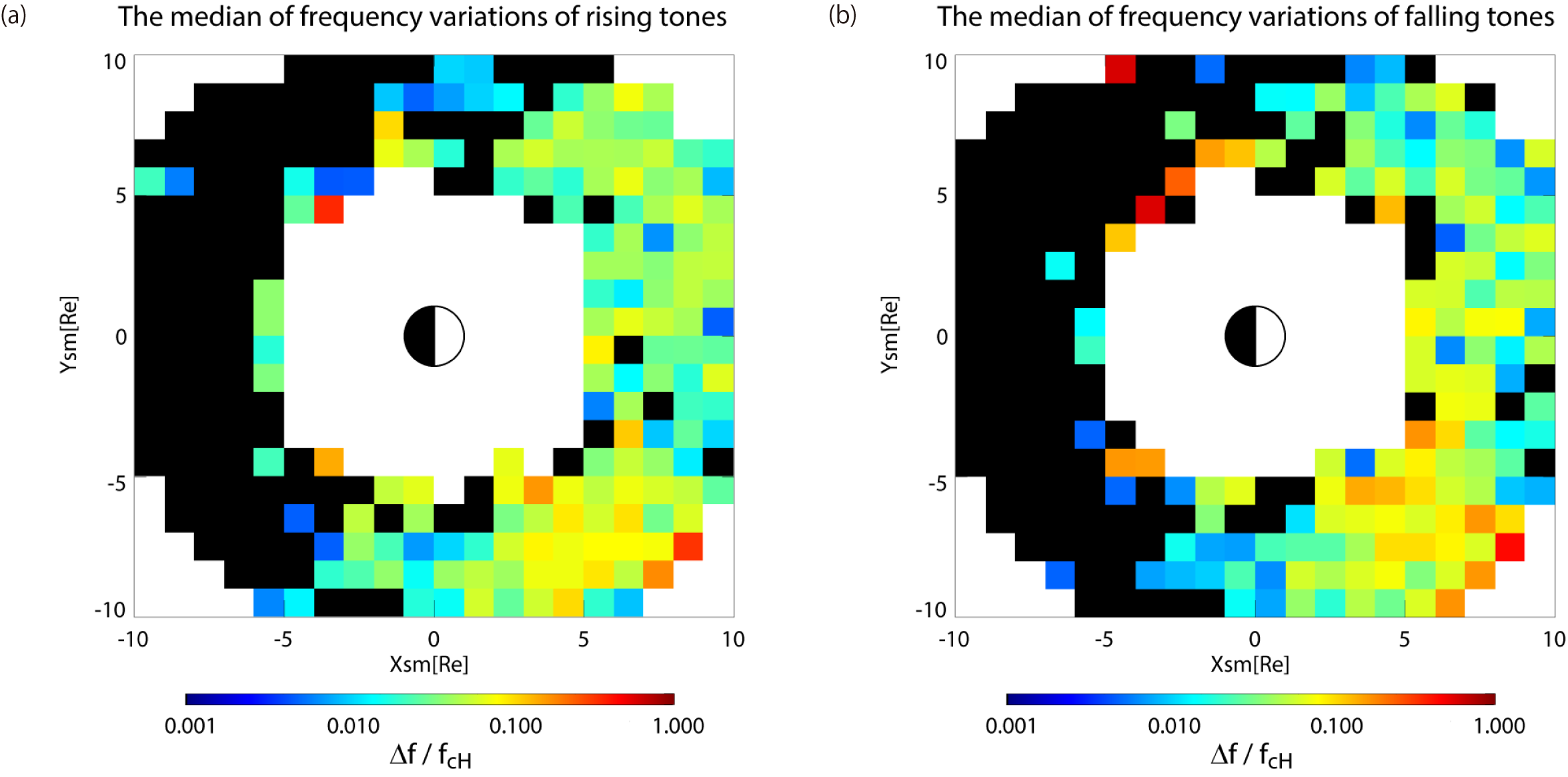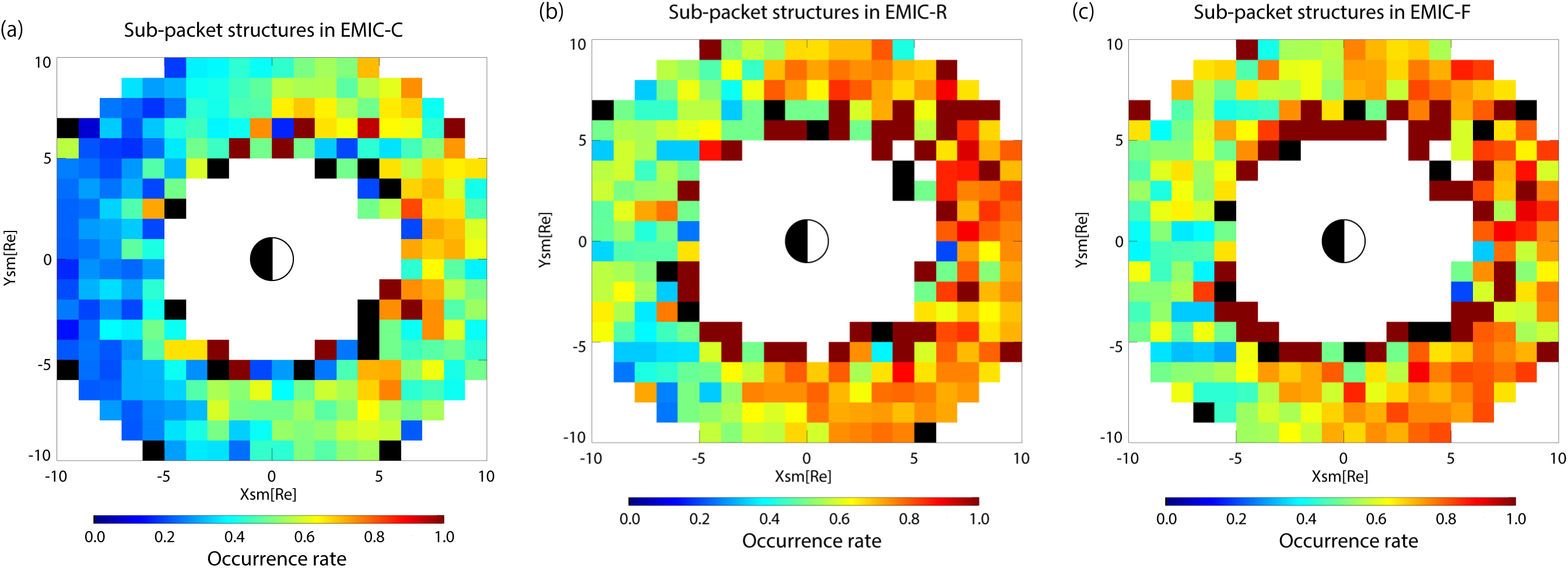
2016 THEMIS SCIENCE NUGGETS
A statistical study of EMIC rising and falling tone emissions observed by THEMIS
by Satoko Nakamura
Research Institute for Sustainable Humanosphere, Japan
formerly at Kyoto University
Introduction
EMIC waves may have significant influence on the magnetospheric dynamics through thermal plasma heating, precipitation of ring current ions, and pitch angle scattering of relativistic electrons. There have been many studies which analyzed electromagnetic ion cyclotron (EMIC) waves statistically by using various satellites.Based on these results, it is revealed that EMIC waves are more likely to occur in the outer region with L value greater than 7. The plasmatrough is not a preferential region for EMIC wave generation because EMIC waves are observed on both inside and outside of the plasmapause.
Cluster observations revealed EMIC waves with fine structures consisting of coherent rising tones [Pickett et al., 2010, Grison et al., 2013]. The EMIC rising tone emissions have received intense attention recently because of their potential importance for energetic particle dynamics in the Earth’s magnetosphere. The purpose of this study is to clarify the occurrence rate of EMIC triggered emissions and the global distribution of statistically. This study is complementary to the previous statistical studies of EMIC waves mentioned above.
| Figure 1. (a) The occurrence rate of all EMIC emissions, (b) the occurrence probability of EMIC-RF events in all EMIC emission events, the occurrence probability of (c) EMIC-R events and (d) EMIC-F events in all EMIC emission events. The figure format is the same as that of figure 2. |
Results
In this paper, we refer EMIC emissions with rising tone frequency, falling tone frequency, and constant frequency as EMIC-R, EMIC-F, and EMIC-C, respectively. Figure 1b shows the occurrence probability of either EMIC-R or EMIC-F events to the all EMIC events. We can find that about 30 % of EMIC waves contain distinct frequency variations on average over the magnetosphere. Around noon, more than 50 % of EMIC waves have EMIC-R or EMIC-F. In the night side, on the other hand, EMIC waves contain almost no obvious frequency variation. Figures 1c and 1d show the occurrence probabilities of EMIC-R events and EMIC-F events to the all EMIC event, respectively. From these figures, we find that EMIC-R events have relatively large occurrence probability in comparison with EMIC-F events.
| Figure 2. Figure 2. The medians of frequency variations in (a) rising tone and (b) falling tone cases. |
We show the global distribution of the median value of the frequency variation in Figure 1. Similar to the overall occurrence rates the frequency ranges have larger values in the dayside magnetosphere. It is noted that we find a maximum peak of the frequency range around the pre-noon sector around 10 MLT in both EMIC-R and –F distributions. We are also interested in a fine structure in the wave amplitude. Figure 3a shows the occurrence rate of sub-packet structures to the EMIC-C events, which means EMIC waves without any notable frequency variation. Figures 3b and 3c show the occurrence rates of sub-packets in EMIC-R and -F, respectively. In these figures, we can see the sub-packet occurrence rate is clearly larger in EMIC-R or -F than that in ambiguous-tone events.
| Figure 3. Occurrence rates of sub-packet structures in (a) EMIC-C, (b) EMIC-R, (c) EMIC-F. |
Conclusion
It is highly possible that strong EMIC waves, especially observed in the dayside magnetosphere, are consist of rising- or falling tones. In addition, most of EMIC-R and -F have sub-packet structures in the amplitude. These features of EMIC emissions with fine structures should be taken into account in investigating the generation mechanism of EMIC waves and their interaction with energetic particles.
Reference
Nakamura, S., Y. Omura, and V. Angelopoulos (2016), A statistical study of EMIC rising and falling tone emissions observed by THEMIS, J. Geophys. Res. Space Physics, 121, 8374–8391, doi:10.1002/2016JA022353.Biographical Note
Satoko Nakamura is a postdoctoral research fellow at Research Institute for Sustainable Humanosphere in Japan. The research was done as a doctoral thesis at Kyoto university.
 Please send comments/suggestions to
Emmanuel Masongsong / emasongsong @ igpp.ucla.edu
Please send comments/suggestions to
Emmanuel Masongsong / emasongsong @ igpp.ucla.edu



